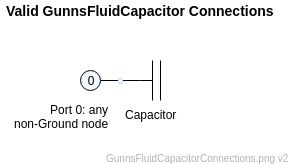GunnsThermalCapacitor - nasa/gunns GitHub Wiki

This link extends GunnsBasicCapacitor and represents a lump of mass and its ability to store heat as thermal capacitance. This link applies its capacitance at the attached basic node. Nodes with an attached capacitor or similar link are called capacitive nodes, those that do not are called non-capacitive nodes.
All nodes in a thermal network should usually have capacitance, because in a physical system there is always some thermal mass associated with the point at which we want to model and observe a temperature.
The capacitor link has user controls to edit the capacitance and to override the node temperature.
Thermal capacitance has units of (J/K) and represents the amount of heat (Joules) to flow into the node to raise its temperature by 1 Kelvin. A useful relationship exists between the capacitance C, and the mass m and Specific Heat Cp of the material represented by the node:
The temperature of the mass represented by the capacitor is assumed to be uniform thoughout the entire lump of mass and is equal to the attached node's potential. So, wherever you want a unique temperature to be modeled in a system, place a node at that point with a thermal capacitor attached. Calculate the capacitance from the represented mass of material and the material's specific heat from the above relationship. Specifc heat is an intrinsic property of materials that is usually well-documented. A capacitor can represent a mix of different materials - simply sum their individual m * Cp products.
This picture shows the proper way the thermal capacitor is connected to a node (we re-use the fluid capacitor's picture because it is attached in the exact same way):

Port Connection Rules (These are limitations on the port connection to nodes that the link enforces in run-time):
- Port 0 must connect to a non-Ground node.
- Port 1 must connect to the Ground node. This port is optional. If not drawn, GunnsDraw will automatically connect it to the Ground node.
Other Rules (These are extra rules you should always try to follow):
- Never put more than one capacitor or other capacitive link on the same node.
- Capacitance provides stability to thermal networks. Fortunately, thermal systems tend to change slowly, so this stability is less of an issue than in fluid and electrical networks. However it is still a good idea to account for all of the real thermal mass of the modeled system at the appropriate node locations in the network.
- A "feature" of GUNNS is that any node or nodes that are isolated from any capacitance or temperature/flow sources have their temperature solve to zero. This is because non-capacitive nodes represent zero thermal mass and temperature is therefore undefined -- the GUNNS solver handles this ambiguity by setting it to zero. To avoid a sensor detecting zero temperature in an isolated node, add some small non-zero capacitance to the node. This is another reason to put capacitors on all nodes in thermal networks.
Configuration Data Parameters:
- editCapacitanceGroup (default = -1): this is currently not used in GunnShow thermal networks.
Input Data Parameters:
- malfBlockageFlag (default = false): Initial state of the blockage malfunction activation flag. NOTE: the blockage malfunction is deliberately not implemented in this link and has no effect.
- malfBlockageValue (default = 0.0, must be (0-1)): Initial state of the blockage malfunction activation value.
- capacitance (default = 0.0 W/K, must be >= 0): Initial capacitance of the thermal mass. This is usually constant for most objects but is technically "input data" to allow for changing capacitance (if an object sheds or gains some mass, etc).
- potential (default = 294.261 K, must > 0): This is the intial temperature of the thermal mass. It overrides the initial temperature of the attached node.
- malfTemperatureOverrideFlag (default = false): Initial state of the temperature override malfunction. This malfunction forces the attached node temperature to the given malfunction value as long as this flag is true.
- malfTemperatureOverrideValue (default = 294.261 K): Initial temperature value of the temperature override malfunction.
- N/A
- N/A